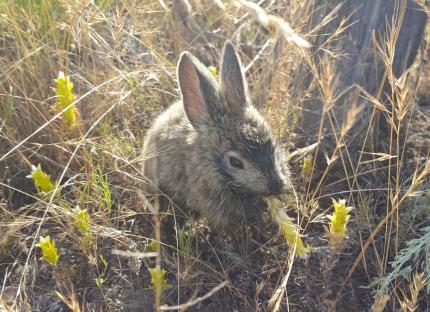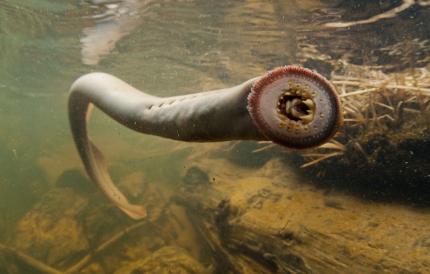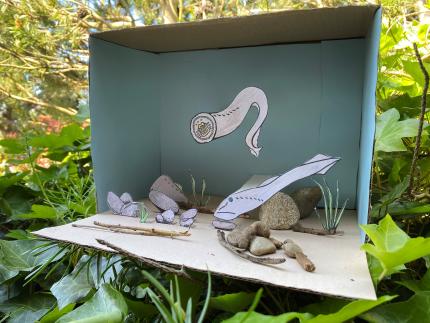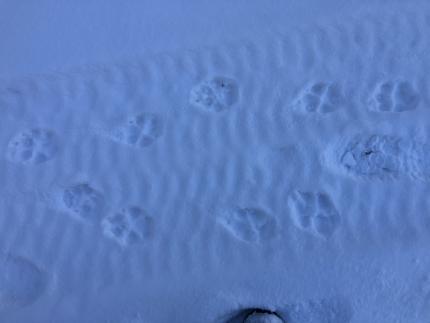There are 268 species of concern in Washington - Let’s protect every one! Washington is home to more than 1,900 species of animals, including at least 40 found nowhere else on Earth.
Despite this natural abundance, 268 Species of Greatest Conservation Need—animals such as golden eagles, fishers, wolverines, pygmy rabbits, bighorn sheep, orcas, white sturgeon, sharptail grouse, bull trout, puffins, western pond turtles, and sandhill cranes – are immediate concerns.
These and other imperiled species may disappear from Washington without wildlife conservation, wildlife recreation, and the work of people that care. Fortunately, Washington has a rich tradition of caring for wildlife, and you play an essential role. In these lessons, we are concentrating on the species most in need of help, endangered species.
Watch this 30-second video of a fisher release. Over the last several years, conservation organizations have worked together to reintroduce fishers in the Cascade Range and Olympic Peninsula.
What is an endangered species?
A species can be a plant (like an oak tree), an animal (like a penguin), a fungus (like a mushroom), or any other form of life. Humans, butterflies, dandelions, coral, zebras, and house cats are all species.
Having all of these species on Earth is called biodiversity. The term biodiversity comes from two very old words: the Greek word bios, which means life, and the Latin word diversitas, which means variety. So, biodiversity means a variety of life. This variety of life helps make our planet special – there are so many species on Earth, we haven’t found them all yet!
Watch the 4-minute video below to learn more about biodiversity.
We work with other conservation organizations around the world to study species to better understand how everything fits together, just like a jigsaw puzzle. This is how we learn about the overall health of the species, and this is where the terms threatened and endangered come in. We will focus only on animals here, but any type of species can become threatened or endangered.
An animal is considered threatened or endangered when there are so few of them left that they are in danger of becoming extinct. Extinct means that there are no more of these animals alive anywhere in the world. Species may become threatened or endangered for many reasons, but two of the most common are loss of habitat and genetic variation.
Loss of genetic variation
Genetic variation is very similar to biodiversity, except that it occurs within a species. Genetic variation is the variety that occurs within a single species. You can see this variation in our pets – even though there are billions of cats and dogs around the world, they all look a little bit different. The greater the number of individuals of a species, the greater the genetic variation. This is a good thing, because greater genetic variation reduces the amount of inbreeding.
Inbreeding is when two closely related individuals of a species reproduce. Because they are related, there is little genetic variability. This makes the offspring (babies) more susceptible to disease and deformities. If an animal is deformed, it might not be able to obtain food easily, and it could starve. If an animal cannot fight off disease or other common illnesses, then it could die. Species with low genetic variability are also not very good at adapting to changes in their habitat, so things like disasters and climate change can be catastrophic to these species.
Loss of genetic variation can occur naturally – this often happens to animals that are only found in very small regions, like islands. The Channel Islands fox, found only on the Channel Islands off the coast of California, is one example.
Human activity can also lead to low genetic variability. Over hunting and fishing, which happens when people take more of a species than is sustainable, can reduce population sizes. When the population is small, there are few individuals to reproduce, which can lead to inbreeding.
Habitat loss
Habitat is the environment in which a species lives. This includes all the things that species needs to survive, such as food, water, and shelter.
Watch this 4-minute video as a refresher on habitat.
Habitat loss, such as converting natural areas to agriculture or housing developments, can also lead to lower population sizes and low genetic variability. But habitat loss also often leads to less food, water, and shelter for the animals that live in that area. If the animals lose their homes because those homes are turned into something else, they may die.
Threatened vs endangered species
So far, we’ve talked about both threatened and endangered species, but is there a difference? The answer is yes. That difference, and the terms you hear, may be different depending on where you live and who you talk to. The International Union for the Conservation of Nature has eight different categories for all species on Earth. The Washington Department of Fish and Wildlife has three categories for species about which we’re concerned: sensitive, threatened, and endangered. You can learn more about which Washington species are sensitive, threatened, or endangered. (PDF)
Watch this 4-minute video to learn more about endangered animals.
You may already be familiar with threatened and endangered species such as tigers, rhinos, and polar bears, but did you know there are threatened and endangered species right here in Washington? Sadly, there are nearly 50 species that are listed (PDF) as sensitive, threatened, or endangered, and there are over 100 more species that WDFW thinks should also be listed. It takes a long process involving many partners from other state and federal agencies, such as the US Fish & Wildlife Service to officially list a species as threatened or endangered.
Pygmy rabbits

One endangered species in Washington is the pygmy rabbit. They are the smallest rabbit in North America, and the adults are so small they can fit in the palm of your hand. These rabbits are only the size of kittens when they’re full grown!
There were many things that contributed to pygmy rabbits becoming endangered, but habitat loss is one of the biggest reasons. These rabbits live in Eastern Washington in shrubsteppe habitat covered in sagebrush. Sagebrush is their main food source, but they also eat grasses and other plants that are available in the spring and summer. Most sagebrush-covered land in Washington has been converted to agricultural land over the last 200 years. These rabbits were once plentiful, but by 2002, there were only 16 pygmy rabbits left in the wild. This led to a loss of genetic variation, which further imperiled the rabbits’ chances for survival.
In 2002, WDFW partnered with the Oregon Zoo, Northwest Trek Wildlife Park, and Washington State University to begin a breeding program with hopes of bringing the population back from extinction. The program wasn’t very successful at first, everyone learned many lessons and now the program is very successful with more than 1,000 pygmy rabbits released back into the wild. Many of these rabbits now breed successfully on their own.
Watch this 2-minute video about WSU’s pygmy rabbit research.
Learn more about pygmy rabbits and their habitat:
Activity: Write for Change
This activity involves research and persuasive writing inspired by the book “Hoot” by Carl Hiaasen. The main character, Roy, is just a normal kid who moves to a new neighborhood, but he stumbles upon a mystery involving a pancake restaurant (yum!) and tiny owls that live underground. Roy learns all about endangered species and works with his friends to convince adults to protect them.
Instructions
- Begin by researching an endangered species or habitat until you find one (or more) you’re interested in. The WDFW and US Fish & Wildlife Service websites are good places to start. Also check out organizations such as National Geographic, the World Wildlife Fund, and the International Union for the Conservation of Nature.
- Once you’ve found a species or habitat that interests you, take thorough notes about problems it is facing and how you think it should be protected.
- Write a letter to your local government official(s) letting them know why you are concerned, and why it’s important to protect this species or habitat. Scholastic’s Write for Change has a template to get you started.
Pacific lamprey

The Pacific lamprey is an eel-like fish that has been around since before dinosaurs! Pacific lamprey are an important part of tribal cultures in the Pacific Northwest and an important part of the ecosystem because they are a food source for other fish, birds, and marine animals. Tribal members have fished for Pacific lamprey and used them in their ceremonies for hundreds of years and have seen their numbers decline.
There are several reasons for this, and one of them is habitat loss. Many animals, like some kinds of salmon, are on a list of threatened and endangered species, but did you know that Pacific lamprey are NOT on the list? Being on the list means a species and its habitat get extra attention and there are government rules for their protection. Because they are not “listed,” it is up to all of us to learn more about Pacific lamprey and to protect their habitat.
Pacific lamprey have different habitat needs throughout their life cycle. After hatching, they drift downstream to areas of slow water and fine sediment, where they burrow and live as filter feeders for up to seven years. We can protect juvenile lamprey habitat by not dredging fine sediment from stream bottoms. Adult Pacific lamprey spawn in stream habitats similar to salmon. Females and males work together, moving rocks with their sucker-like mouths to create a nest or “redd” where the eggs are deposited and fertilized. When we protect and restore salmon habitat, we are also helping lamprey!
Watch this 2-minute video by the Oregon Zoo about Pacific lamprey.
Learn more about Pacific lamprey:
- Follow Luna the Lamprey on Facebook
- Watch this 25-minute video produced by Freshwaters Illustrated in partnership with the Columbia River Inter-Tribal Fish Commission
Activity: Pacific Lamprey spawning habitat shadowbox
Gather your materials

- Small cardboard box
- Either stiff cardstock OR regular paper and thin cardboard (like a cereal box)
- Pacific lamprey stream habitat cutouts (PDF)
- Scissors
- Glue or tape
- Paint or colored paper
- Crayons or colored pencils
- Small sticks and rocks (optional)
Instructions
- Print the Pacific lamprey stream habitat cutouts (PDF) on regular paper or stiff cardstock. If you used regular paper, glue the sheet to your thin cardboard.
- Color in the scene. Pacific lamprey are gray/brown with blue eyes and yellow teeth!
- Cut out the pieces and fold each tab on the stream habitat.
- Cut off three flaps of your box but leave one long flap to serve as your stream bed. Keep the cut off flaps to use later.
- Paint the inside of your box blue or cover in blue paper to represent water.
- Paint the bottom of your box brown and or cover in brown paper to represent the sand and rocks that make up the stream substrate (if your box is already brown, you could skip this step).
- Create your stream habitat scene:
- Glue down the plant and rock layers.
- Cut two long pieces from the box flaps from earlier and fold down the ends to make supports for your lamprey.
- Glue the supports to the lamprey and the box so they stand out.
- Optional: glue small sticks and rocks on the bottom flap for added stream habitat detail.
Tracking Wolves
In this activity, middle school learners join wolf biologist Gabe Spence in his work tracking wolves. First, they learn how to find and identify wolf tracks from other animal tracks. Next they learn about how wolves move (called a gait). The activity ends with students looking for wolf tracks in their local outdoor space in small groups.

This activity uses writing, mapping, observational, and investigative skills. The activity is best done in areas where wolves are found; however if you do not live in, or are unable to travel to wolf country, you can modify parts of the activity to include animals in your area.
Activity Plan
Supporting Materials
How you can help
Parents, teachers, and students have played a critical role in species and habitat conservation by sharing what they know and encouraging others to care. Young people can share their interest with others, re-awakening love for nature among adults, and sharing this love with their peers. Caring and sharing is one of the most important things you can do.
Watch this 5-minute video of a school group working to release salmon into local streams.
Activity: Participate in a cleanup
Frogs and fish depend on clean river banks, and ocean birds, shellfish, and mammals depend on clean beaches. Leave the places you hike and play cleaner than when you came to give animals a healthy home. Here are a few organizations active in clean-up efforts:
Do your part to make your home and yard wildlife friendly
Securing your garbage from wildlife, bird-proofing windows with homemade decals, and never purchasing products made of endangered wildlife or endangered forest species are all great places to start!
Native plants are ones that were originally found in the area, before humans began building. Why are native plants important, and how are they different from other plants? Well, all plants are native to somewhere, but a tree that is native to Japan, for instance, might not be as good of an idea to plant in Western Washington as a tree that is native to this area. This is because the insects, birds, and other animals are adapted to use native trees for their food and shelter (their habitat!).
To become adapted to something means that you (or the animal) is used to the conditions. Planting a garden featuring native plants with your family, spring through fall, means you help to provide cover at a time of year that is especially crucial for pollinators, who rely on floral nectar and pollen for food. Don’t have space? Even container gardens and birdbaths provide food and habitat for pollinators.
Threatened and endangered species and how to help them
- Scholastic Endangered ecosystems books and resources
- Idaho Public Broadcasting Endangered species books
- San Diego Zoo Online games
- Oregon Public Broadcasting 1-hour film on invasive species
- TEDEd (makers of TED Talks) Earth School, a series of videos and activities about the natural